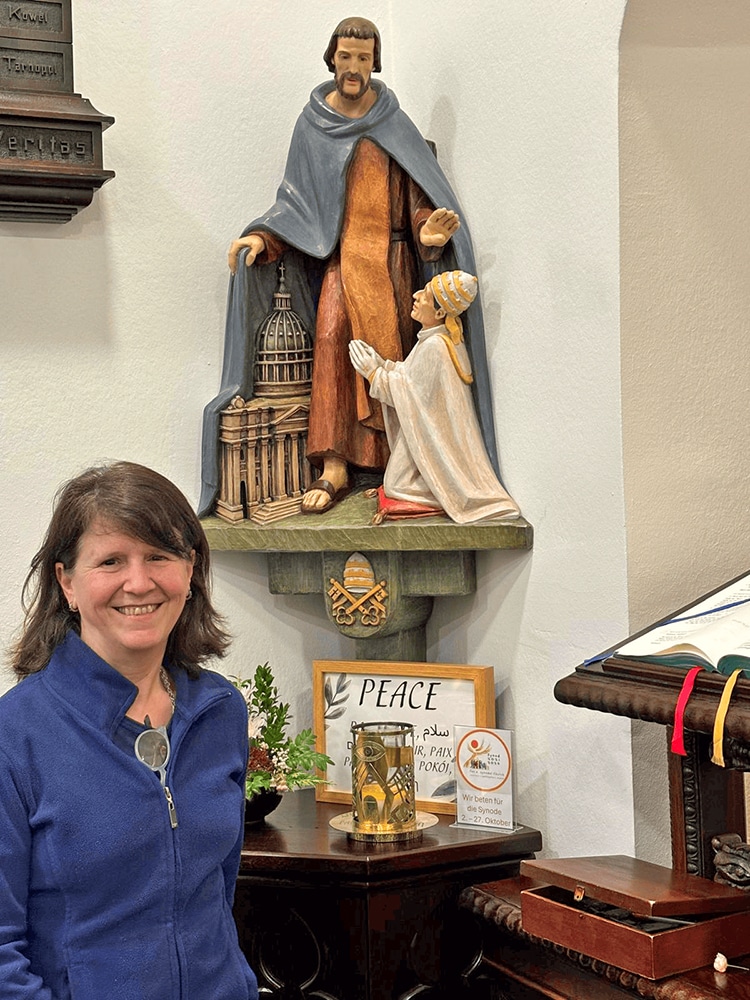Durante os meses de setembro a novembro de 2024, a artista argentina Silvana Frías trabalhou na renovação de algumas imagens importantes do Santuário Original de Schoenstatt.
Ela realizou trabalhos de conservação – em alguns casos restauração – das principais figuras do Santuário. São elas: a imagem da Mãe, as imagens de São Pedro e São Paulo, as imagens de São José e São Vicente Pallotti, bem como a imagem do Arcanjo Miguel. Ela também trabalhou em alguns pequenos detalhes de algumas peças quebradas do retábulo (frontal do Santuário).
Silvana, assim como seu pai, dedica-se à restauração de peças históricas, especialmente as sacras. Com vasta experiência, ela nos conta como foi fazer esse trabalho e seus desejos, agora que as imagens estão prontas:
A senhora já conhecia Schoenstatt? Qual sua impressão ao visitar este lugar?
Sim, eu conhecia Schoenstatt. Cresci na Argentina com as Irmãs de Maria, estudei em seu colégio, dessa forma, desde muito jovem convivi com as Irmãs e conheci Schoenstatt e o Padre Kentenich. Além disso, tive a oportunidade de me reconhecer como membro da Família de Schoenstatt. Para mim, quando visito qualquer lugar de Schoenstatt no mundo, sempre tenho a impressão de que me sinto em casa. E muito mais foi a impressão quando cheguei à Alemanha, um lugar onde sempre tivemos o coração voltado, onde a aliança aconteceu, onde o Pai selou a Aliança de Amor com Maria. Por causa da língua e de tudo o mais, pensei que poderia ser complicado me comunicar e me relacionar, mas a verdade é que, onde quer que você esteja, Schoenstatt é sempre uma família.

Como foi a experiência de trabalhar na restauração das peças do Santuário Original?
Para mim, foi uma honra e uma responsabilidade o fato de a Mãe de Deus ter me escolhido para realizar esse trabalho. Foi muito emocionante e também significou uma grande responsabilidade, pois tive que proteger e cuidar de todas as imagens que historicamente estiveram junto do Pai e dos primeiros em Schoenstatt.
Portanto, para mim foi muito emocionante poder fazer isso, poder dar isso a Schoenstatt e às pessoas que virão ao Santuário no futuro, e também foi uma grande responsabilidade preservar absolutamente tudo o que tem grande valor histórico neste lugar.
Há alguma peça em que tenha sido mais especial trabalhar? Qual delas a impressionou mais?
Obviamente, sim. A imagem da Mãe foi extremamente importante para mim. Bem emocionante para mim, porque ela é minha mãe, minha guia, minha companheira. Então, é uma imagem que me acompanha, que minha família ama e a tem como mãe. Em minha casa há um Santuário Lar – tanto na minha casa, quanto na casa de meus pais. Por isso, para mim foi muito forte e gerou muito amor e muita emoção em meu coração poder restaurá-la e imaginar o Pai e os primeiros congregados, os primeiros membros de Schoenstatt olhando para essa imagem, rezando, colocando nela toda a sua espiritualidade e seus desejos. Sei que, para mim, foi muito emocionante e importante poder fazer isso e poder dar a ela, à Virgem Maria, o que ela tão ricamente merece.

Do ponto de vista técnico, que cuidados foram necessários para preservar essas imagens de valor histórico?
Foi muito importante determinar o que deveria ser conservado e o que deveria ser restaurado. Havia partes que estavam extremamente degradadas e não podiam ser preservadas do ponto de vista técnico.
Quando algumas partes das peças se deterioram excessivamente com o passar do tempo, devido à sujeira, à erosão causada pela limpeza e também à degradação dos materiais originais com os quais foram feitas, é necessário um processo de restauração. E o que foi preservado ao longo do tempo é conservado.
Em outras palavras, nessas peças, em qualquer uma que for restaurada, deve-se dar prioridade ao seu valor histórico e artístico. É preciso respeitar o que o artista fez e o que as pessoas consideram importante em uma peça desse lugar. Essas pessoas são importantes para estudar e ver o desenvolvimento de uma restauração. E, acima de tudo, é preciso respeitar as origens do artista e as pessoas que guardam essas peças.
Assim, cada uma delas recebeu diferentes técnicas de restauração: poligrafia, madeira, douramento etc. Em outras palavras, foram realizadas em todas elas uma primeira medida de conservação e, no caso das peças que estavam muito danificadas, uma forma de restauração.
Olhando para o seu trabalho finalizado, tem algum desejo especial?
Quando vejo tudo pronto, meu maior desejo e minha maior vontade é que todos que entrarem no santuário possam ver nelas a beleza de Deus, possam ver a luminosidade, a luz dessas imagens que têm tanta oração e tanta força nelas.
Sempre que faço uma restauração, meu desejo é que as pessoas possam ver nelas, ver nas imagens, a beleza de Deus, a estética de Deus, a linda imensidão de Deus.
É isso que eu espero, que isso realmente gere uma oração e possa elevar o coração de todos aqueles que rezam diante dessas imagens.
